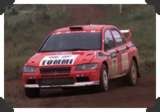|
|
|
|
 |
While all other teams had immediately switched to World Rally Cars, Mitsubishi continued to run Group A Lancer for years even though they got waivers to deviate from strict Group A rules so that late Evo's no longer were pure Group A cars. In the end, World Rally Car concept proved to offer performance advantages that even Mitsubishi couldn't ignore and Lancer WRC was introduced in San Remo 2001. Despite called Lancer, the car is actually based on sister-model Cedia.
Lancer WRC was developed in relatively short time and many key component were carried over from Group A Lancer. Engine was largely same though internal dimensions were different and certain parts had been lightened to decrease rotating part inertia. Drivetrain was exactly the same which in the end proved to be one of the weak points of the car.
Improvements that WRCar format allowed were longer suspension travel because of larger wheel arches, improved cooling with new intercooler positioning and rearward tilt of the engine to improve weight distribution. Rear suspension was changed to McPherson struts and wheelbase was longer though car's overall length remained almost the same.
Refined version, known as WRC Step 2 or WRC2 for short, was introduced in Finland 2002 but it was not a big step ahead. Car which had essentially been built around Tommi Makinen, required aggressive left-foot braking approach and team's non-scandinavian drivers Delecour and Alister McRae struggled to get in terms with that. In the end, Mitsubishi decided to take sabbatical to organise their efforts.
|
|
|
 |
| Debut WRC event: | San Remo 2001 |
| Best WRC result: | 5th by Alister McRae in Sweden 2002 |
| Rallies contested: | 18 | (works entries) |
| WRC starts: | 42 | (works entries) |
| Outright wins: | 0 | |
| Podiums: | 0 | |
| DNF's: | 20 | (DNF's to starts ratio 47.6 %) |
| Points scored: | 12 | (manufacturer championship points) |
| Avg points per rally: | 0.7 | |
|
| Group and class | World Rally Car |
| Engine |
| Location: | Front transverse |
| Turbo: | Yes |
| Cylinders: | 4 in line |
| Valves: | 16 |
| Bore x stroke: | 85.5 x 86.9 mm |
| Cubic capacity: | 1996 cc |
| Power: | 300 hp |
| Torque: | 540 Nm |
| Dimensions |
| Length: | 4360 mm |
| Width: | 1770 mm |
| Height: | 1430 mm |
| Wheelbase: | 2600 mm |
| Front track: | 1550 mm |
| Rear track: | 1550 mm |
| Weight: | 1230 kg |
| Transmission |
| Drive: | 4WD |
| Gearbox: | Longitudinal |
| Gears: | 6 |
| Sequential: | Yes |
| Clutch plates: | 3 |
|
|
 |
Disappointing Lancer WRC on it's way to sixth place in Australia 2001, driven by Makinen
 |
|
Note
|
|
Statistics include both the original WRC and WRC Step 2.
|
|